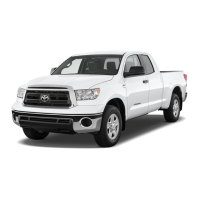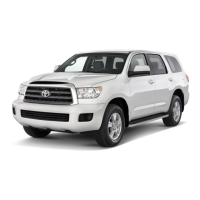Do you have a question about the Toyota 2011 Matrix and is the answer not in the manual?
Information about keys, key number plate, and precautions when riding in an aircraft.
Instructions on using wireless remote control, key, or door lock switch to lock/unlock vehicle doors.
Guidance on adjusting front seats, rear seats, head restraints, steering wheel, and mirrors.
Instructions for operating power windows and moon roof, including lock switch functionality.
Steps for opening the fuel tank cap and important cautions regarding refueling the vehicle.
Information on the engine immobilizer system, its maintenance, and potential malfunction causes.
Details on SRS airbags, components, deployment conditions, and essential safety precautions.
Essential procedures for starting, driving, and parking the vehicle, covering automatic and manual transmissions.
Explanation of the gauges, meters, and displays on the instrument cluster when the engine switch is ON.
Information on indicator and warning lights that inform the driver of the vehicle's system status.
Instructions on operating headlights, fog lights, and turn signals, as well as windshield wipers and washers.
How to use the cruise control system to maintain a set speed without using the accelerator pedal.
Explanation of systems like ABS, Brake Assist, VSC, TRAC, EPS, and Active Torque Control 4WD.
Guidelines on storage precautions, cargo capacity, load limits, and distribution for safe driving.
Instructions on adjusting temperature, fan speed, and air outlets for the air conditioning and heating system.
Overview of different audio system types, including CD player and AM/FM radio functions.
Enables enjoying music from portable players via wireless communication using Bluetooth®.
Features and operation of the hands-free phone system, allowing calls without cables or phone operation.
Identification of interior lights, including personal and general interior lighting.
Overview of storage spaces like auxiliary boxes, glove box, bottle holders, cup holders, and console box.
Instructions on how to use and position the sun visors for optimal sun protection.
Procedures for washing, waxing, and protecting the vehicle's exterior, including care for aluminum wheels and bumpers.
Guidelines for cleaning and protecting the vehicle's interior, including leather and synthetic leather areas.
Information on general, scheduled, and do-it-yourself maintenance, including warranty coverage considerations.
Essential precautions and tools required for performing DIY maintenance on the vehicle.
Safety precautions and component identification for working in the engine compartment.
Guidance on checking tires, tire rotation, and the tire pressure warning system (if equipped).
Instructions for removing, replacing, and checking the air conditioning filter for optimal efficiency.
Steps for replacing the battery in the wireless remote control key.
Procedure for checking and replacing fuses in the engine compartment and under the driver's side instrument panel.
Instructions on how to use emergency flashers if the vehicle malfunctions or is involved in an accident.
Recommendations for towing your vehicle, including proper procedures and types of trucks or dollies to use.
Guidance on what to do when warning lights or buzzers activate, including brake system and charging system warnings.
Precautions and instructions for safely using the tire jack to lift the vehicle for tire replacement.
Troubleshooting steps if the engine does not start, covering starter motor, battery, and immobilizer system issues.
Emergency procedure to shift the lever out of P if it cannot be moved normally, potentially due to a shift lock system issue.
Information on how to obtain new genuine keys from a Toyota dealer if your keys are lost.
Procedures for jump-starting the engine using jumper cables and another vehicle.
Precautions for avoiding battery fires or explosions, and handling battery fluids safely.
Procedure to follow if the engine overheats, including checking for steam, fans, and coolant levels.
Procedures to free the vehicle if it becomes stuck in mud, dirt, or snow, and cautions when shifting the lever.
Troubleshooting steps if the engine does not start, covering starter motor, battery, and immobilizer system issues.
Procedures for jump-starting the engine using jumper cables and another vehicle.
Key dimensions like overall length, width, height, wheelbase, tread, vehicle capacity, and towing capacity.
Information on the Vehicle Identification Number (VIN) location and its importance for registration.
Detailed engine specifications including model, type, bore, stroke, displacement, drive belt tension, and valve clearance.
Details on fuel type, octane rating, and fuel tank capacity.
Recommendations for engine oil grade, viscosity, and capacity for proper lubrication.
Details on cooling system capacity and coolant type, and spark plug specifications.
Customizable settings for wireless remote control functions like unlocking, door locks, and operation signals.
Items that must be initialized for normal system operation, such as maintenance data and tire pressure warning system.
Information on how to report vehicle defects to NHTSA and Toyota Motor Sales, U.S.A., Inc.
French explanation of seat belt instructions, with reference to English details.
French explanation of SRS airbag instructions, with reference to English details.
Information about keys, key number plate, and precautions when riding in an aircraft.
Instructions on using wireless remote control, key, or door lock switch to lock/unlock vehicle doors.
Guidance on adjusting front seats, rear seats, head restraints, steering wheel, and mirrors.
Instructions for operating power windows and moon roof, including lock switch functionality.
Steps for opening the fuel tank cap and important cautions regarding refueling the vehicle.
Information on the engine immobilizer system, its maintenance, and potential malfunction causes.
Details on SRS airbags, components, deployment conditions, and essential safety precautions.
Essential procedures for starting, driving, and parking the vehicle, covering automatic and manual transmissions.
Explanation of the gauges, meters, and displays on the instrument cluster when the engine switch is ON.
Information on indicator and warning lights that inform the driver of the vehicle's system status.
Instructions on operating headlights, fog lights, and turn signals, as well as windshield wipers and washers.
How to use the cruise control system to maintain a set speed without using the accelerator pedal.
Explanation of systems like ABS, Brake Assist, VSC, TRAC, EPS, and Active Torque Control 4WD.
Guidelines on storage precautions, cargo capacity, load limits, and distribution for safe driving.
Instructions on adjusting temperature, fan speed, and air outlets for the air conditioning and heating system.
Overview of different audio system types, including CD player and AM/FM radio functions.
Enables enjoying music from portable players via wireless communication using Bluetooth®.
Features and operation of the hands-free phone system, allowing calls without cables or phone operation.
Identification of interior lights, including personal and general interior lighting.
Overview of storage spaces like auxiliary boxes, glove box, bottle holders, cup holders, and console box.
Instructions on how to use and position the sun visors for optimal sun protection.
Procedures for washing, waxing, and protecting the vehicle's exterior, including care for aluminum wheels and bumpers.
Guidelines for cleaning and protecting the vehicle's interior, including leather and synthetic leather areas.
Information on general, scheduled, and do-it-yourself maintenance, including warranty coverage considerations.
Essential precautions and tools required for performing DIY maintenance on the vehicle.
Safety precautions and component identification for working in the engine compartment.
Guidance on checking tires, tire rotation, and the tire pressure warning system (if equipped).
Instructions for removing, replacing, and checking the air conditioning filter for optimal efficiency.
Steps for replacing the battery in the wireless remote control key.
Procedure for checking and replacing fuses in the engine compartment and under the driver's side instrument panel.
Instructions on how to use emergency flashers if the vehicle malfunctions or is involved in an accident.
Recommendations for towing your vehicle, including proper procedures and types of trucks or dollies to use.
Guidance on what to do when warning lights or buzzers activate, including brake system and charging system warnings.
Precautions and instructions for safely using the tire jack to lift the vehicle for tire replacement.
Troubleshooting steps if the engine does not start, covering starter motor, battery, and immobilizer system issues.
Emergency procedure to shift the lever out of P if it cannot be moved normally, potentially due to a shift lock system issue.
Information on how to obtain new genuine keys from a Toyota dealer if your keys are lost.
Procedures for jump-starting the engine using jumper cables and another vehicle.
Precautions for avoiding battery fires or explosions, and handling battery fluids safely.
Procedure to follow if the engine overheats, including checking for steam, fans, and coolant levels.
Procedures to free the vehicle if it becomes stuck in mud, dirt, or snow, and cautions when shifting the lever.
Troubleshooting steps if the engine does not start, covering starter motor, battery, and immobilizer system issues.
Procedures for jump-starting the engine using jumper cables and another vehicle.
Key dimensions like overall length, width, height, wheelbase, tread, vehicle capacity, and towing capacity.
Information on the Vehicle Identification Number (VIN) location and its importance for registration.
Detailed engine specifications including model, type, bore, stroke, displacement, drive belt tension, and valve clearance.
Details on fuel type, octane rating, and fuel tank capacity.
Recommendations for engine oil grade, viscosity, and capacity for proper lubrication.
Details on cooling system capacity and coolant type, and spark plug specifications.
Customizable settings for wireless remote control functions like unlocking, door locks, and operation signals.
Items that must be initialized for normal system operation, such as maintenance data and tire pressure warning system.
Information on how to report vehicle defects to NHTSA and Toyota Motor Sales, U.S.A., Inc.
French explanation of seat belt instructions, with reference to English details.
French explanation of SRS airbag instructions, with reference to English details.
| Brand | Toyota |
|---|---|
| Model | 2011 Matrix |
| Category | Automobile |
| Language | English |












